The subalpine life zone in Colorado:
A. occurs above 11,400 feet in elevation
B. above the grasslands life zone
C. contains a greater number of species than the foothills life zone
D. has greater precipitation than the foothills life zone
E. b & d
|
|
E. b & d
above the grasslands life zone
has greater precipitation than the foothills life zone
|
| |
Deciduous plants are more likely found in:
A. Desert
B. Tropical rainforest
C. Grassland
D. Temperate Forest
E. Boreal Forest
|
|
D. Temperate Forest |
| |
Ecology is the study of how:
A. atoms make up the environment.
B. humans affect the environment.
C. organisms interact with each other and their nonliving environment.
D. societies pass laws to protect the environment.
E. evolution affects nature
|
|
C. organisms interact with each other and their nonliving environment. |
| |
What is the correct sequence of these ecological areas from largest to smallest?
Ecosystem, Population, Biome, Landscape, Community
A. Ecosystem, Biome, Community, Landscape, Population
B. Biome, Ecosystem, Landscape, Population, Community
C. Biome, Landscape, Ecosystem, Community, Population
D. Biome, Ecosystem, Community, Landscape, Population
E. C & D |
|
E. C & D
Biome, Landscape, Ecosystem, Community, Population
Biome, Ecosystem, Community, Landscape, Population
|
| |
Precipitation and temperature are generally the limiting factor that controls the vegetative character of:
A. Biomes
B. Ecosystem.
C. Habitat
D. A, B & C
E. A & B |
|
D. A, B & C
Biomes
Ecosystems
Habitat
|
| |
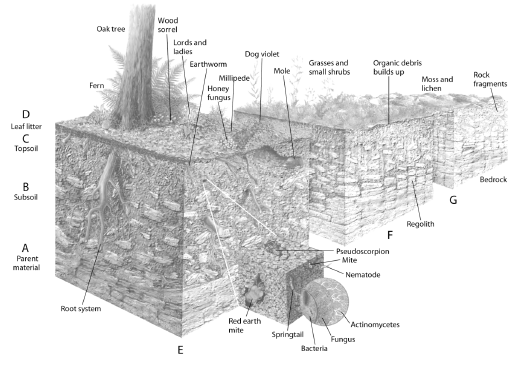
image
The soil horizon that contains mineral soil and little organic matter is:
A. A.
B. B.
C. C.
D. D.
E. O.
|
|
B |
| |
The process of desertification is increased by:
A. poor agricultural practices
B. overgrazing
C. economic conditions
D. A & B
E. all of the above |
|
all of the above
poor agricultural practices
overgrazing
economic conditions
|
| |
Carrying capacity
A. measures stream flow and the ability to move sediment
B. how much air pollution the atmosphere in Denver can carry before acid rain begins to drop
C. how many individuals an ecosystem can contain without negatively impacting the environment
D. how many individuals an ecosystem can contain during a time of environmental stress
E. how many deer can survive in the city of Boulder eating neighborhood gardens and flowers. |
|
C. how many individuals an ecosystem can contain without negatively impacting the environment |
| |
Exponential growth graphically represents:
A. rapidly increasing populations
B. carrying capacity
C. populations approaching sustainability
D. A & B
E. all of the above |
|
A. rapidly increasing populations |
| |
Tragedy of the commons refers to:
A. common resources are used up the fastest
B. rare resources are used up the fastest
C. common resources are abused because they occur everywhere
D. rare resources are more expensive
E. B & C. |
|
C. common resources are abused because they occur everywhere |
| |
El Nino can effect weather in Colorado because
A. it reverses current flow in the South Pacific
B. it reverses current flow in the Gulf of Mexico
C. changes the pattern of weather in India
D. results from unusual rainy conditions in Australia
E. A & E |
|
A. it reverses current flow in the South Pacific |
| |
Ecosystems function through the interaction of:
A. Producers, consumers and abiotic elements
B. Nutrients, water and erosion
C. Nutrients, sunlight and animals
D. Producers, consumers and biotic elements
E. Animals, plants and populations |
|
A. Producers, consumers and abiotic elements |
| |
Alpine Tundra versus Arctic Tundra
A. has abundant available moisture
B. has deep permafrost
C. has shallow soils
D. has limited daylight in winter
E. B and D |
|
C. has shallow soils |
| |
The most permeable soil will be:
A. Clay
B. Loam
C. Sand
D. Dust
E. a mix of sand with loam |
|
C. Sand |
| |
The majority of deserts in the world occur:
A. near the tropic of Cancer
B along the equator
C. in the southern hemisphere
D. near the tropic of Capricorn
E. in the polar regions |
|
A. near the tropic of Cancer |
| |
There is more precipitation at higher elevations because:
A. warm air rises
B. water condenses from cooler air more than from warm air
C. water is frozen at higher elevation for a longer period
D. A & B
E. B and C |
|
D. A & B
warm air rises
water condenses from cooler air more than from warm air
|
| |
Salinization such as found throughout the West is the result of:
A. evaporation
B. nitrates in the soil
C. closed basins
D. A & C
E. all of the above |
|
D. A & C
evaporation
closed basins
|
| |
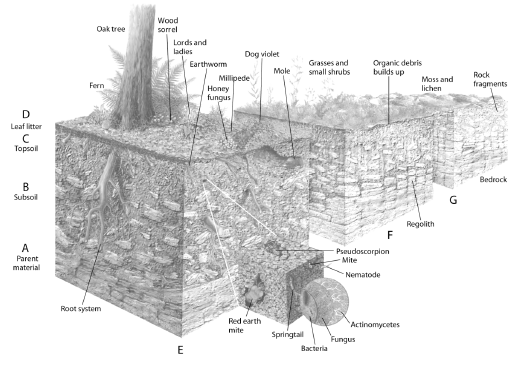
From the image choose the appropriate letter to answer the questions below.
On the soil formation and generalized soil profile figure, choose the soil that consists of undecomposed leaves, twigs, crop waste, animal waste, fungi, and other materials.
|
|
C |
| |
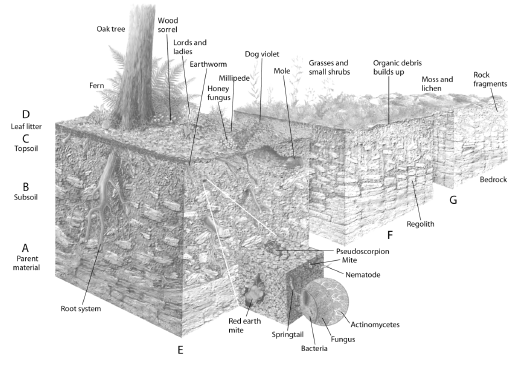
From the image choose the appropriate letter to answer the questions below.
On the soil formation and generalized soil profile figure, choose the layer of the mature soil that contains root systems.
|
|
C |
| |
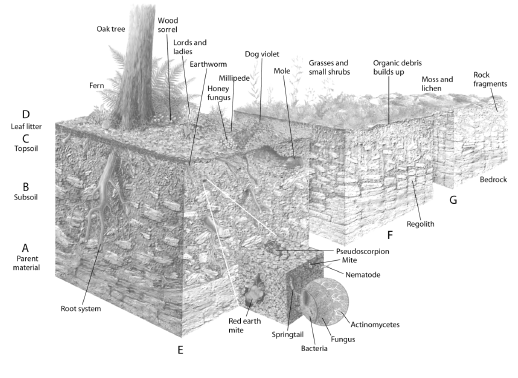
From the image choose the appropriate letter to answer the questions below.
On the soil formation and generalized soil profile figure, choose the soil that is porous and contains humus.
|
|
B |
| |
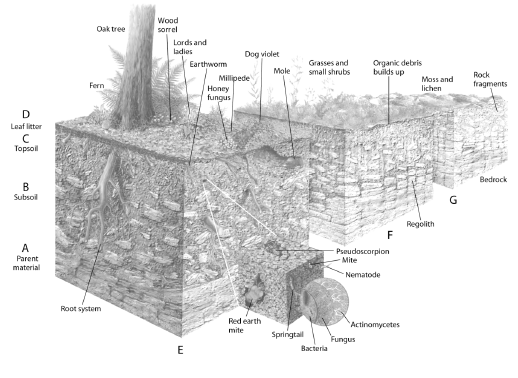
From the image choose the appropriate letter to answer the questions below.
On the soil formation and generalized soil profile figure, choose the layer we called the C Horizon in lecture |
|
A |
| |
All of the brown tree frogs and green tree frogs living in the same area would be part of the same population
A. True
B. False |
|
B. False
they are apart of the same community but they are not the same population because of the ditstinct species difference
|
| |
There is greater diversity in forests than in grasslands due to:
a. seasonal differences.
b. greater organic matter in the soil.
c. runoff.
d. vertical structure.
e. reduced impact from wind and snow. |
|
d. vertical structure. |
| |
Soil textures with moderate physical and chemical properties include
a. silt and loam.
b. sand and loam.
c. clay and loam.
d. clay and silt.
e. sand and clay |
|
a. silt and loam. |
| |
The dissolving of material from the upper layers of the soil and its movement to lower horizons is called
a. percolation.
b. weathering.
c. accumulation.
d. leaching.
e. humus |
|
d. leaching. |
| |
Topsoil contains all of the following except
a. plant roots.
b. humus.
c. freshly fallen leaves.
d. some inorganic minerals.
e. bacteria |
|
c. freshly fallen leaves. |
| |
Daily weather patterns in the Front Range of Colorado are strongly influenced by:
a. cool air rising in the mountains
b. warm air sinking at night.
c. warm air rising into the mountains.
d. humidity levels in Denver.
e. c and d |
|
e. c and d
warm air rising into the mountains.
humidity levels in Denver.
|
| |
The most important factor in determining which biome is found in a particular area is
a. soil type.
b. topography.
c. magnetic fields.
d. climate.
e. longitude |
|
d. climate. |
| |
Which of the following statements is false?
a. About one-third of the solar energy hitting the earth is immediately reflected back to space.
b. A spectrum of electromagnetic radiation emanates from the sun.
c. About one-third of the solar energy hitting the earth warms the land and lower atmosphere, runs cycles of matter, and generates winds.
d. Less than 1% of sunlight is captured via photosynthesis.
e. None of these answers. |
|
c. About one-third of the solar energy hitting the earth warms the land
and lower atmosphere, runs cycles of matter, and generates winds. |
| |
A community of living organisms interacting with one another and the physical and chemical factors of their nonliving environment is called
a. a species.
b. an ecosystem.
c. a population.
d. a lithosphere.
e. a community |
|
b. an ecosystem |
| |
There is greater available water in the lower montane that in the subalpine due to?
a. Greater precipitation.
b. Less wind
c. Longer growing season
d. Less intense solar radiation.
e. A & B |
|
c. Longer growing season |
| |
Which of the following microclimate effects is incorrectly described?
a. The leeward sides of high mountains tend to show relatively dry conditions.
b. Oceans and lakes modify temperature extremes.
c. Forests have fewer temperature extremes and lower wind speeds than nearby open land.
d. Cities tend to have lower temperatures and higher wind speeds than the surrounding
countryside.
e. The windward sides of high mountains tend to show relatively wet conditions. |
|
d. Cities tend to have lower temperatures and higher wind speeds than the surrounding
countryside. |
| |
Climate and vegetation primarily vary with
a. latitude only.
b. altitude only.
c. latitude and altitude.
d. latitude and longitude.
e. altitude and longitude |
|
c. latitude and altitude. |
| |
Trees of wet tropical rain forests tend to be
a. succulent plants.
b. broad-leaf evergreen plants.
c. broadleaf deciduous plants.
d. coniferous evergreen plants.
e. coniferous deciduous plants. |
|
b. broad-leaf evergreen plants. |
| |
You read the data records of a field ecologist who reports the following varieties of species: beetles, spiders, grasshoppers, many insects and invertebrates, earthworms, prairie dogs, rabbits, squirrels, meadowlarks, coyotes, foxes, hawks. You conclude that the field ecologist is located in a
a. desert.
b. tropical grassland.
c. temperate grassland.
d. arctic tundra.
e. taiga |
|
c. temperate grassland. |
| |
Which of the following describes where a natural grassland would most likely be found?
a. where annual precipitation exceeds 45 inches
b. where drought and fire are very rare
c. in places that are suitable for forests but also experience grazing
d. in the zone lying between forest and desert
e. none of these answers |
|
d. in the zone lying between forest and desert |
| |
Most of the nutrients in the tropical rain forests are found in the
a. living organisms.
b. large rivers.
c. deep, rich soil.
d. thick atmosphere.
e. shallow soil |
|
a. living organisms. |
| |
Mature temperate deciduous forests _____ than tropical rain forests.
a. have more different tree species
b. have more different animal species
c. have more plant life at ground level
d. have less sunlight penetrating to lower levels
e. have less plant life at ground level |
|
c. have more plant life at ground level |
| |
Deserts are primarily located in the hot, tropical equatorial regions.
a. TRUE
b. FALSE |
|
b. FALSE |
| |
At a population growth rate of 1.0% the worlds’ population will double in approximately
a. 10 years
b. 20 years
c. 50 years
d. 70 years
e. 83 years |
|
d. 70 years |
| |
